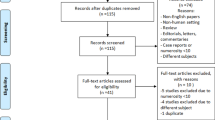Abstract
Thirty-three patients with congenital penile deviation were examined by a semistructured interview and psychodiagnostic tests (Gießen test, Gießen complaint sheet) prior to undergoing surgery according to the Nesbit-Kelâmi technique [7]. A prognosis was then made to determine the extent to which the problems and disturbances reported by the patient or uncovered by the examiner could be improved by the operation. This prognostic assessment was then verified in a subsequent catamnestic examination (N=20), at an average of 21.3 months after the intervention.
An attempt is made to identify and define preoperative indicators that permit to predict the postoperative course.
Similar content being viewed by others
References
Dosuzkov, Th.: Zur Frage der Dysmorphophobie.Psyche, 23, 683 (1969).
Eicher, W., Herms, V., Hüter, J., Kubli, F.: Psychologische Aspekte bei plastischer Chirurgie der Mamma.Fortschr. Med., 92, 1407 (1974).
Hill, G., Silver, A. G.: Psychodynamic and esthetic motivations for plastic surgery.Psychosomat. Med., 12, 345 (1950).
Huenecke, P., Bosse, K.: Dysmorphophobia as casus pro diagnosis.Z. Hautkr., 60, 86 (1985).
Kelâmi, A.: Classification of congenital and acquired penile deviation.Urol. Int., 35, 229 (1983).
Kelâmi, A.: Klinik und Praxis: Penisdeviation.Urologe [A],24, 160 (1985).
Kelâmi, A.: Congenital penile deviation and its treatment with the Nesbit-Kelâmi technique.Br. J. Urol., 69, 261 (1987).
Küchenhoff, J.: Dysmorphophobie.Nervenarzt, 55, 122 (1984).
Mester, H.: Der Wunsch einer Frau nach Veränderung der Busengröß—Ein Beitrag zur Frage der Dysmorphophobie.Z. Psychosom. Med., 28, 69 (1982).
Meyer, E.: Motivational patterns in patients seeking elective plastic surgery.Psychosom. Med., 22, 193 (1960).
Myron, L., Belfer, M., Mulliken, J. B., Cochran, Th. C. Jr.: Cosmetic surgery as an antecedent of life change.Am. J. Psychiat., 136, 199 (1979).
Neumann, A.: Dysmorphophobie: Ein Erfahrungsbereich aus der chirurgischen Spezialsprechstunde.Handchirurgie, 19, 134 (1987).
Rechenberger, K., Molinski, H.: Psychische und körperliche Reaktionen nach kosmetischen Brustoperationen.Fortschr. Med., 17, 1129 (1977).
Roubicek, A.: Zur Psychopathologie der kosmetischen Fehler, besonders jener der Gesichtsbildung.Med. Kosmetik, 9 21 (1968).
Schepank, H.: Beeinträchtigungsschwerescore. In: Psychogene Erkrankungen der Stadtbevölkerung. Springer, Berlin-Heidelberg-New York 1987.
Strain, F.: Die Dysmorphophobie als Kontraindikation kosmetischer Operationen.Handchirurgie, 16, 193 (1984).
Author information
Authors and Affiliations
Rights and permissions
About this article
Cite this article
Keller, W., Köpp, W., Wunder, B. et al. Psychosomatic evaluation of patients with congenital penile deviation. A postoperative catamnestic follow-up. International Urology and Nephrology 24, 439–446 (1992). https://doi.org/10.1007/BF02550639
Accepted:
Issue Date:
DOI: https://doi.org/10.1007/BF02550639




